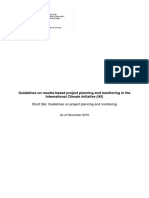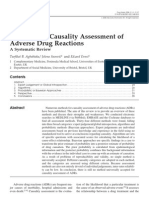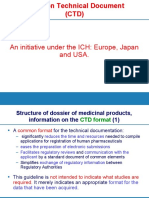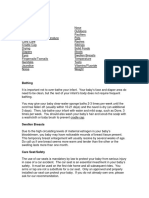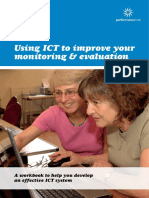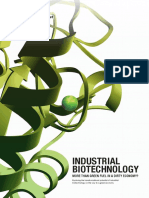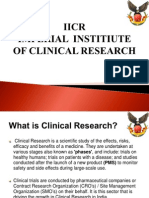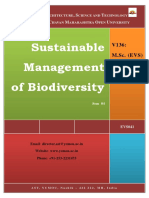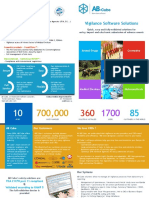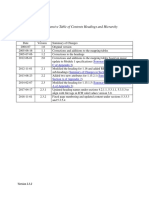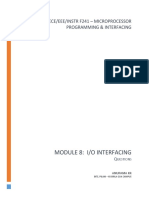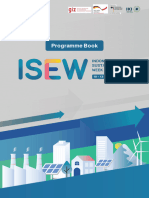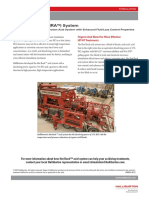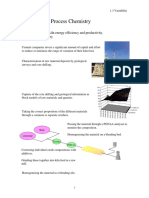12/2/2014
CDM:UnderstandingAdditionality
The Clean Development Mechanism
Draft Working Paper
THE CLEAN DEVELOPMENT MECHANISM: UNDERSTANDING
ADDITIONALITY
Kevin A. Baumert, WRI
World Resources Institute
This paper examines the question of additionality, which is dealt
with in Article 12.5 of the Kyoto Protocol in the context of defining
the Clean Development Mechanism (CDM). The Protocol requires
that emission reductions certified under the CDM be "additional" to
what would have occurred in the absence of project activities. This
paper treats two main components of the subject: financial and
environmental additionality. No specific recommendations are made
below, but rather implications of various ways of applying
additionality some of them quite controversial are explored. The
first section explains the importance of additionality and establishes
conceptual definitions for financial and environmental additionality.
The second section treats the range of definitions and
interpretations of financial additionality, and the third explains
baseline construction methodologies that have been put forth to
measure environmental additionality. These methodologies can be
divided into two categories: "topdown" baselines derived from
aggregate national or sectoral emissions data or "bottomup"
baselines derived from specific projects.
I. What is Additionality and Why is it Important?
The Kyoto Protocol created a suite of "flexibility mechanisms." In
addition to the Clean Development Mechanism (CDM), an instrument
for cooperation between developed (Annex I) countries and
developing (nonAnnex I) countries, the flexibility mechanisms
include international emissions trading (Article 17); Joint
Implementation between Annex I countries (JI, Article 6); and
bubbles (Article 4). More than the other mechanisms, the CDM has
the potential to reward projects that do not limit emissions, or that
would have occurred anyway. To guard against this possibility,
Article 12.5 of the Kyoto Protocol stipulates that greenhouse gas
reductions that take place under this mechanism must be
"additional to any that would otherwise occur in the absence of the
certified project activity" (emphasis added). This criterion, coupled
with other United Nations Framework Convention on Climate
Change language,1 has given birth to a broad range of definitions
and assumptions about additionality and its implications.
Financial Additionality:2 Financial additionality refers to whether
http://figueresonline.com/csdafinal/English/publications/cdm/wp.baumert.html
1/16
�12/2/2014
CDM:UnderstandingAdditionality
project investment would have taken place in the absence of the
creditgaining CDM provisions. According to some interpretations of
Article 12.5(c), projects that would have taken place anyway so
called "anyway projects" are not eligible for certified emission
reductions3 (CERs) under the CDM.
The example below illustrates one way of conceptualising financial
additionality:
For SOLAR COMPANY to undertake a solar instal lation
project in a developing country, an expected rate of
return of 15 percent is needed. Without crediting, the
expected rate of return is 10 percent, and the project
will not be undertaken. However, under the credit
granting CDM, the rate of return is 20 percent (because
of the asset value of the credits), and SOLAR COMPANY
will implement the project. This project is financially
additional. Alternatively, however, if the return on the
investment without credits was 15 percent, then the
project would not be financially additional, because it
"would have taken place" without the CDM.
Although specific definitions have been put forth, there is no
universally recognised definition of financial additionality. But what
is important, is how (or if) to apply the concept of financial
additionality, embodied in Article 12.5(c), and avoid credits from
being generated from "anyway" projects.
Environmental Additionality:4 Environmental additionality refers
both to Article 12.5(c), cited above, and Article 12.5(b): "Emission
reductions resulting from each project activity shall be
certified...on the basis of...real, measurable, and longterm
benefits related to the mitigation of climate change" (emphasis
added). Unlike financial additionality, which is usually expressed
categorically (in the form of "yes" a project is financially additional,
or "no" it is not), environmental additionality can be measured, and
is expressed quantitatively to satisfy the "real, measurable"
component of Article 12.5(b). For example, SOLAR COMPANY must
now calculate the overall amount of greenhouse gases (GHGs)
abated by the project relative to a baseline. This calculation is the
quantitative basis for obtaining certified emission reduction credits,
and nonenvironmentally additional projects can in no way earn
credits through CDM project activities. Determining environmental
additionality requires:
1. a project baseline, or reference case, that estimates what
would have happened in the absence of the CDM project
methodologies for estimating a projects actual GHG emissions
http://figueresonline.com/csdafinal/English/publications/cdm/wp.baumert.html
2/16
�12/2/2014
CDM:UnderstandingAdditionality
or sequestration
2. a quantitative comparison of actual emissions to baseline
projections. The difference between the baseline and actual
emissions (i.e. the amount of GHGs abated) is the amount of
environmental additionality achieved by the project.
Thus, environmental additionality answers the question, "How many
CERs should a project generate?" Or alternatively, "What quantity of
GHGs were abated by the project?" As with financial additionality,
there is no common and widely accepted methodology for
measuring GHG reductions.
Significance of the Additionality Debate: The primary importance of
the additionality debate is ensuring the environmental integrity of
the Kyoto Protocol. Including businessasusual (nonfinancially
additional) projects in the CDM will increase global GHG emissions.5
The same is true if lax methodologies prevent an accurate
quantification of environmental additionality "overcrediting"
projects from developing countries will introduce "paper tons" into
an international emissions trading system. In contrast, overly
stringent definitions of additionality will discourage project
implementation and exclude legitimate GHGreducing projects.
Thus, it has been correctly suggested that tradeoffs are needed;
the costs of measuring additionality (which affect incentives,
administrative ease, etc.) must be weighed against the accuracy of
the measurements (Heister,1997).
Moreover, additionality is a key component of CDM project
eligibility. Article 12.5 specifies the basis upon which such emission
reductions shall be certified (i.e. what is eligible). Sections (b) and
(c) of Article 12.5, as discussed above, address additionality.6 Thus,
project eligibility is a function of how the additionality criteria are
applied. Projects that are CDMeligible could be defined in terms of
environmental additionality only; environmental and financial
additionality; specific categories of projects that are a priori
eligible; sustainable development benefits; or a combination of
these and other criteria. Regardless, additionality will play a key
role in some fashion because all CDM activities must be
environmentally additional.
Third, common definitions are needed before projects can be
credited. In the Activities Implemented Jointly (AIJ) pilot phase,
determining financial and environmental additionality occurs at the
national level under the jurisdiction of AIJ programs (for example,
USIJI in the United States and JPAIJ in Japan). This has led to a
proliferation of methodologies and definitions. Because of the asset
value of certified emission reductions, a mature crediting CDM
regime will require consistent application of the additionality
http://figueresonline.com/csdafinal/English/publications/cdm/wp.baumert.html
3/16
�12/2/2014
CDM:UnderstandingAdditionality
criteria and methodologies by all Parties. The early
crediting/banking provision in Article 12.10 (credits may be
obtained beginning in 2000) makes this particularly pressing for the
CDM.
II. Financial Additionality:
Referring to additionality, a USIJI report to the UNFCCC Secretariat
states that "In practice this has been a particularly difficult criteria
to apply" (Carter,1997, emphasis added). The hypothetical nature of
additionality, definitional confusion and the need to determine the
intent of the investor are components of the challenge of applying
financial additionality.7 This is further complicated by "no regrets"
projects or other "profitable" ventures that have both environmental
and economic benefits.8 Coaltogas fuel switching projects, for
example, may lower GHG emissions and are often economically
rational. Such projects would likely not pass a strict financial
additionality test because they would be undertaken by the host
country or a foreign investor in the absence of the credit granting
CDM.
There are several problems, however, with an approach that
excludes projects with both economic and environmental (in terms
of GHG reductions) benefits. Foremost among them is the fact that
there are no guarantees that "no regrets" projects will in fact take
place. Many argue that failure to undertake such projects is at the
heart of the climate problem. The US Environmental Protection
Agency's voluntary industry outreach programs such as Energy Star,
Green Lights and Climate Wise aim to overcome nonprice barriers
such as lack of information, uncertainty over future conditions and
risk aversion that prevent "no regrets" measures from being
executed.
Recognizing the challenges posed by hypothetical baseline
scenarios, multiple definitions, and unexploited "no regrets"
projects, several options for operationalizing financial additionality
and Article 12.5(c) include:9
1. Accept all projects financed outside of Official Development
Assistance (ODA) and the Global Environment Fund (GEF) as
financially additional. This approach, taken by USIJI, would be
simple to administer and is most consistent with COP decision
5/CP.1, which established the AIJ Pilot Phase. 10 Under it, USAID
related projects, for example, would be excluded from CDM
crediting. NorthSouth equity issues drive this component of the
financial additionality debate, because the CDM could reorientate
ODA or GEF flows toward GHG reduction projects, at the expense of
pursuing other important development goals. CDM flows, it is often
http://figueresonline.com/csdafinal/English/publications/cdm/wp.baumert.html
4/16
�12/2/2014
CDM:UnderstandingAdditionality
argued, should create a new source of private development funding,
rather than take place at the expense of existing development
assistance programs. A variation of this option, which would yield
similar results in practice, is to accept any private sector financed
project as financially additional. This would also enable some
government funded CDM projects to be eligible, if it was adequately
demonstrated that ODA funding was new and additional, as the
Swiss AIJ programs shows.11 The World Bank notes that "private
sector investment [in AIJ] is generally recognised as inherently
additional."12
2. Accept any project initiated by the host country as financially
additional. This guideline would enable developing countries to
implement their own project or portfolio of projects and generate
CERs to market through the CDM. Perhaps it can be reasonably
assured that CDM projects proposed by hosts that are eventually
financed by Annex I entities "would not have taken place otherwise"
and are therefore financially additional.
3. Accept any project included in categories that are a priority
considered financially additional. Like several other approaches,
categorization of projects would be extremely easy to administer.
All renewable energy projects, for example, could be considered
automatically additional, for an agreed upon period of time. This
approach promotes projects that are likely to embody positive
externalities and helps overcome investment barriers for noncarbon
technologies (Michaelowa and Dutschke,1998). The viability of this
approach depends almost completely on the selection of categories.
4. Accept any project that demonstrates, through financial analysis,
that the project would not have taken place "but for" CERs. CERs
represent a potential asset stream from project activities that can
boost the return on investment. Requiring a demonstration that
CERs enable the project to be implemented is a rigorous guideline,
but also the most consistent with the financial additionality
example illustrated in the first section. Several challenges posed by
this criterion include the unknown future value of CERs, the
potential for manipulation of financial analysis, and high transaction
costs.
5. Accept any project that demonstrates that the project overcomes
"barriers" to implementation. CDM projects that overcome market
failures, or institutional, technological, or other barriers would be
considered financially additional. Overcoming barriers to
implementation, such as lack of information or risk aversion, is
precisely the rationale for government programs that promote "no
regrets" action and is also a component of the USIJI additionality
criteria.13 Evaluation of the barrier(s) identified by project
http://figueresonline.com/csdafinal/English/publications/cdm/wp.baumert.html
5/16
�12/2/2014
CDM:UnderstandingAdditionality
developers, conducted by the CDM Executive Board or other body,
would be required to ensure that they are indeed real. The "barrier
removal method," advanced by the International Energy Agency
could serve as a model (IEA,1997).
6. Accept any project that demonstrates "program additionality."
Borrowed from USIJI, this option stipulates that project developers
may demonstrate that the investment is being initiated directly as a
result of the CDM, or in reasonable anticipation of the CDM.14
Project proponents can demonstrate this by documenting that the
project was initiated specifically for the CDM in response to
workshops, host outreach efforts, or consultations.
7. No financial additionality criteria. Some have suggested that only
an environmental additionality test is desirable and that financial
additionality "adds transaction costs without enhancing
environmental performance."15 Under this argument, actual project
emissions, assessed in relation to baselines, should be the only
criterion for assessing additionality. In many cases, financial
additionality arguments may be a vestige of AIJ programs, which do
not involve crediting and thus do not require rigorous environmental
additionality measurements. Dropping the financial additionality
requirement would need to be complemented by rigorous bottomup
baseline determination methodologies (see below) that capture
businessasusual scenarios and ensure that "anyway" projects are
not credited.
A combination of the above approaches could also serve as a basis
for determining financial additionality. For example, some criteria
could be established as necessary, but not sufficient, for
demonstrating financial additionality. Others could be deemed
sufficient.
III. Environmental Additionality and Baselines
Because CERs are potentially valuable assets, useful in
demonstrating domestic or international regulatory compliance, the
subject of accurately quantifying GHG reductions is particularly
important. Determining environmental additionality requires a
quantitative comparison of actual project emissions to baseline
projections. The most crucial component to determining
environmental additionality is the project baseline, which defines
the scenario that "would have taken place" in the absence of the
CDM project.16 Several approaches, which are summarized below,
have been put forth as possible methodologies for determining the
baseline of a project. For simplicity, the methodologies are
categorized into two general approaches those derived from
aggregate data, or "topdown" baselines, and those determined
http://figueresonline.com/csdafinal/English/publications/cdm/wp.baumert.html
6/16
�12/2/2014
CDM:UnderstandingAdditionality
casebycase, or "bottomup" baselines. Within each approach,
baselines can be historical or forward looking; dynamic or static; or
rate or tonbased.
1. TopDown Baselines.
Topdown baselines typically derive an "emission rate" from existing
national or sectoral data or establish a "cap" on company, sector, or
national emission levels. Examples of topdown baselines which
often use precise metrics to capture the GHGintensity of a country
or sector include:
GHG emissions/megawatt hour (using national energy
production data),
GHG emissions/average mileage (using national transportation
sector data),
GHG emissions/$ of output (using sector or company data),
GHG emissions/unit of output (using sector or company data),
and
Total emissions in the energy generation sector (using absolute
emission projections).
To determine a project's actual emission reductions (its
environmental additionality) during a given period, the
national/sectoral emission rate (such as kg C/MWh) is compared to
actual project emission rate (kg C/MWh). The difference between
the two rates, in terms of actual tons of GHG emissions, is the
quantitative basis for determining CERs. Most proponents of this
approach believe that baselines should remain fixed over the
lifetime of the project. However, the national/sectoral emission
rates can be recalculated on a yearly basis for new CDM projects
coming on line (Hamwey and Szekely,1998).
Historical topdown baselines. Some proponents of "topdown"
baselines argue that "previous and existing sectoral activities in any
national setting, largely implemented in the absence of climate
change considerations, provide the best gauge of what future
activities would be implemented in nearterm national [businessas
usual] scenarios."17 Thus, historically based "topdown" baselines
use current or past national/sectoral data to determine the
appropriate emission rate.
One detailed proposal, by Hamwey and Szekely (1998), uses this
approach for determining baselines in the energy sector. This
"observable baseline framework" uses a national emissions factor,
which is calculated by dividing total annual CO2 emissions by the
total energy generated in this sector (kg C/MWh). To ensure that
projects well above the average are undertaken (and to avoid
possible technology "dumping"), the national emissions factor (i.e.
http://figueresonline.com/csdafinal/English/publications/cdm/wp.baumert.html
7/16
�12/2/2014
CDM:UnderstandingAdditionality
baseline) could be calculated by including only the top tier of
efficient facilities (Hamwey and Szekely,1998).
Forward looking topdown baselines. Similar rates can also be
derived by projecting national and sectoral trends. For example,
forecasting emission rates in the energy sector, using already
planned technologies, would be one means of more accurately
accounting for future change. Another example of this kind of
baseline is a national emission reduction or limitation commitment,
expressed in tons of carbon equivalent. Project baselines could be
apportioned from such a quantitative national cap.
Advantages of "topdown" approaches include low transaction costs,
potentially larger investment flows, easy comparison and "GHG
growth potential" for developing countries.
Transaction costs for investors are low because baselines for
an entire country or sector are pre determined annually by
national governments and/or UNFCCC bodies. Investors do not
need to undertake detailed and expensive studies to
determine a project's baseline. Similarly, regulators do not
need to undertake a caseby case approval process
(CCAP,1998). In addition, this approach is quantitatively
precise, and the calculations relatively simple.
Topdown approaches reduce leakage potential and indirect
effects of CDM projects. The emissions implications of a
sectorwide energy price increase, for example, would be
better accounted for in a system that covered total sectoral
emissions.
Because of the low transaction costs and lack of administrative
burden, greater CDM flows could be generated.
"Emission rates" are easy to compare across sectors and
countries to determine where the greatest potential exists for
CDM projects. This comparability, using metrics that express
carbon intensity, will dynamically promote investment toward
the most inefficient countries and sectors (Hamwey and
Szekely,1998).
The least developed countries should find top down baselines
appealing because they are not based strictly on emission
reductions. Some countries do not have plentiful emission
reduction opportunities simply because actual emission levels
are extremely low in most cases ordersofmagnitude lower
than transition al and industrialized countries. Table 1
illustrates the tremendous emissions disparities in non Annex I
countries. Topdown baselines allow CERs to include "avoided
future emissions" as well as true emission reductions, helping
to ensure that the least developed countries are not
overlooked by CDM investors, as they have been in the AIJ
http://figueresonline.com/csdafinal/English/publications/cdm/wp.baumert.html
8/16
�12/2/2014
CDM:UnderstandingAdditionality
pilot phase (see Sokona et al.,1998).
Drawbacks of this approach include comprehensive data
requirements, poor host country investment incentives, and the
possible expectation of developing country emission reduction
commitments.
Measurement requirements are high under most topdown
systems. The costs of developing the capacity to accurately
measure emissions in all relevant countries and sectors would
be signifi cant. Countries would need to establish compre
hensive measuring and monitoring programs for their national
and/or sectoral emissions. The difficulty in gathering the
requisite data would vary greatly across countries.
A topdown, ratebased approach would allow developing
countries to increase overall GHG emission levels. Would this
qualify as a "real" reduction? Many believe it would not, even
when compared against "real" increases in GHG emissions
under businessasusual scenarios in developing countries. One
danger of allowing CERs to be based on "avoided future
emissions" is that it will enable Annex I countries to emit more
domestically. This approach would allow the largest flow of
CERs, which would, in turn, allow Annex I Parties significantly
higher levels of domestic emissions.
Historical approaches such as the "observable baseline
framework" do not capture marginal decisions, which are
crucial in determining "what would otherwise have happened."
For example, a countrys energy sector could be pre
dominantly coaloriented, yet this does not mean that the
next plant built will also be coalpow ered. Marginal increases
in energy generation capacity may include lower carbon
options, such as combinedcycle gas turbines, even under a
businessasusual projection. The historical approach also
ignores regional considerations because all sectoral sources
regardless of loca tion are subject to the same baseline.
Host countries will have incentives to keep emis sion rates as
high as possible for the purpose of attracting investment.
Thus, there is an incentive for highcarbon domestic
investments (which will keep national/sectoral emission rates
high) and for overstating domestic emissions. Domestic
mitigation incentives could be created by ensuring that hosts
can also implement pro jects and market certified emission
reductions through the CDM.
The easiest way to formulate topdown baselines is to derive
them from an overall GHG limitation or reduction target
(rather than measured data). Because of possible links to
voluntary or binding commitments, many developing countries
may be reluctant to advocate this approach.
http://figueresonline.com/csdafinal/English/publications/cdm/wp.baumert.html
9/16
�12/2/2014
CDM:UnderstandingAdditionality
2. BottomUp Baselines19
The key conceptual difference between topdown and bottomup
baselines is that the latter are determined on a casebycase basis.
While topdown approaches use aggregated national or sectoral
data, as described above, bottomup approaches use a specific
technology or reference case for comparison. Bottomup baselines
do not require large amounts of national or sectoral data to
formulate a baseline. A project baseline of this kind may take the
form of a benchmark emission rate or it may be a measureable
amount, for instance, tons of carbon equivalent.
As with all baselines, determining environmental additionality
requires a comparison between the project baseline and the actual
project emissions. For example, a fuelswitching or efficiency
improvement project would use the emission rate of the old plant
(kg carbon/MWh) as the baseline. Comparing this figure to the
emission rate of the new facility would allow for calculation of the
amount of GHGs abated. Similarly, the actual or projected emission
level of the old plant (measured in tons) could be the basis for
determining the baseline. The overriding baseline challenges are
determining what technologies to benchmark and estimating when
technologies will shift (Chomitz,1998).
Options for bottomup baselines include:
Historical bottomup baselines. Like "observable baselines,"
historical benchmarks look to the past as an indicator for what will
likely happen in the future. New projects may have a very clear
reference case or comparison group representing "present practice,"
from which to compare emission scenarios and determine
environmental additionality. For example, a demandside
management (DSM) project that switches to more energy efficient
lighting practices can be compared to the currently installed
system. The resulting difference in energy saved could be converted
into tons of carbon. The strengths of this method include its ease
ofuse and straightforward basis of comparison. However, it may not
be applicable to many nontechnology based projects or programs,
and is a static model that may become quickly outdated. One way
to deal with this problem is to gradually "deflate" the baseline over
time.
Forwardlooking, bottomup baselines. Other benchmarks rely on
energy or technology forecasts in developing countries. This may
help overcome the static shortcomings of historical reference cases
and capture the marginal decisions that affect GHG emissions. For
example, if new coalfired power plants are already planned in a
developing country, they could serve as the baseline for less carbon
intensive power generation projects implemented through the CDM.
http://figueresonline.com/csdafinal/English/publications/cdm/wp.baumert.html
10/16
�12/2/2014
CDM:UnderstandingAdditionality
Alternatively, forwardlooking benchmarks could be based on the
"best planned technology" or projected emissions for a process or
source. To try to capture businessasusual efficiency
improvements, benchmarks rates or emission levels can decline over
time, until projects eventually fail to earn additional CERs.
Drawbacks include a lack of reliable or credible forecast data.
3. Baseline Mitigation Measures
Project baselines are by definition hypothetical. They will never
happen, and conclusive answers will never be gleaned from baseline
projections. Recognizing that differing assumptions will invariably
yield differing outcomes of baseline estimations, proposals have also
been put forth that attempt to mitigate the uncertainty, rather
than tackle it directly as the above methodologies attempt.
Mitigation strategies, which could be used in concert with
estimation techniques discussed above, include:
Offsets Averaging. This approach pools projects together for
certification of emission reductions. The hope is that inaccurate
environmental additionality estimations of individual projects will
be balanced by other projects that overestimate reductions. By
certifying projects collectively, the risk of overcrediting individual
projects is minimized. Offsets averaging is consistent with the World
Banks Prototype Carbon Fund, portfolios of projects developed by
individual investors, and the hostdriven portfolio approach to the
CDM.20
Discounting. Projects that are "discounted" are granted only partial
credit for certified GHG reductions. Discounting may take place at
the project level, sector level (e.g. all landuse change projects) or
system level (all CDM projects). Reasons for discounting credits
include:
Uncertainties in baselines estimations or uncertain project
emission measurements. Projects in sectors with difficultto
measure emissions, as well as leakageprone or policyoriented
"projects" (such as carbon taxes) may be discounted for this
reason. For example, impermanence of forest sector
reductions could be subject to sectorlevel discounting.
Intertemporal uncertainty.21 Progressively higher discount
rates over time may be desirable for many projects because of
increasing baseline uncertainty. For example, baseline
estimation will be more accurate during the early years of a
project than 30 years in the future. Discounting over time will
help account for shifts in technology or procedures that are
expected to take place at some unknown future date. This is
one means of making baselines dynamic over time and is an
alternative to "deflating" emission rates, discussed above.
http://figueresonline.com/csdafinal/English/publications/cdm/wp.baumert.html
11/16
�12/2/2014
CDM:UnderstandingAdditionality
"Supplementarity" purposes. Discounting may be a means of
ensuring that overseas domestic greenhouse gas reductions are
balanced by domestic action, as specified in Article 12.22
Limiting project lifetimes. Similar in intent to intertemporal
discounting, this measure establishes a concrete limit to the length
of time that a project may earn CERs.
Limiting project eligibility. Projects or programs with particularly
difficult emission or baseline estimations could be rendered CDM
ineligible. This is compatible with the option of "categorizing"
projects that are a priori financially additional (or eligible), as
discussed in the previous section.
Voluntary GHG targets for host countries.
Establishing emission limitations (concrete assigned amounts) for
nonAnnex I countries would greatly alter the significance of
environmental additionality. Host country targets would transform
the CDM into a mechanism similar to Article 6JI, which involves
only countries with binding emission limitation commitments. Here,
emission reductions are a "zerosum" game GHG reductions from a
project are added to the assigned amount of the investor country
and subtracted from the assigned amount of the host country.23 The
amount of GHG emission credits generated by a project does not
alter the global allowable amount of emissions.24 Some have
advocated this approach precisely because it prevents domestic or
international leakage and adds to the environmental integrity of the
CDM. Environmentally speaking, measuring GHG reductions would
become of secondary importance, and any methodology could be
used, provided it is agreed upon by all Parties involved. This would
be consistent with resurrecting the "lost Article 10," which dealt
with "voluntary commitments" of developing countries and could
also be a "stepping stone" for emissions trading between Annex I and
nonAnnex I countries.25
4. Baseline Measurement Units: Rates or Tons?
The units chosen to express baseline estimations could have
implications on CDM crediting. Generally, baselines can be
expressed in amounts or rates, for instance, in units of carbon
equivalent (tons) or emission rates (tons/MWh). A tonbased system
may prevent crediting from taking place while developing countries
are rapidly increasing GHG emission levels because the focus is on
verified actual emission reductions. The ratebased approach, as
discussed above, allows for the possibility that CERs may be
generated from "avoided future emissions." Although not intended
to be quantitatively precise, Table 2 is indicative of different
outcomes that can be expected from baselines that are ratebased
or tonbased.
http://figueresonline.com/csdafinal/English/publications/cdm/wp.baumert.html
12/16
�12/2/2014
CDM:UnderstandingAdditionality
The example illustrates the way in which drastic and unforeseen
future events could cause projects to be "miscredited." In a ton
based system, economic collapse could result in overcrediting,
because baselines would greatly exceed actual emissions.
Conversely, unforecasted growth could result in undercrediting (or
no crediting) because total emission levels would increase, despite
a lower GHGintensity (Scenario 2). In the ratebased system,
unforecasted growth could result in large quantities of CERs being
generated while emission levels increase in the host country. There
is disagreement whether "avoided future emissions" (which could be
credited under a ratebased approach) qualify as "real" reductions,
even under businessasusual growth scenarios in developing
countries. Because of these relationships, it may be desirable to use
a ratebased approach for new emission sources and other projects
with especially unpredictable energy forecasts. Baselines expressed
in absolute amounts (for instance, tons of carbon) may be desirable
for projects that have fixed energy inputs.
Summary and Conclusions:
It is important to distinguish between financial and environmental
additionality, two closely related, but distinct issues. A high degree
of definitional confusion is associated with financial additionality:
within the additionality debate, financial additionality is often not
defined or not distinguished from environmental additionality.26 Or,
alternatively, it is often defined only in the following terms: "non
ODA and nonGEF projects are financially additional." The second
section of this paper outlines seven possible options for applying the
financial additionality criterion. The strongest options are those
that do not entail high transaction costs, but do define clear
categories of projects that are financially additional.
The definition of environmental additionality, on the other hand, is
straightforward and simple. However, this criterion poses other
challenges, namely in developing methodological approaches to
accurately and consistently compute environmental additionality.
Critical to this calculation is the baseline, which can be derived
using "topdown" or "bottomup" methodologies, as discussed in the
third section. Alternatively, the approaches could be combined in a
way that maximizes the comparative strengths of each. Using a
combination of topdown and bottomup approaches for various
sectors and project types with appropriate mitigation measures
(such as discounting or offsets averaging) for projects that are
particularly prone to leakage, baseline uncertainly, shifting
technologies or negative externalities may be the most desirable
approach.
Notes:
http://figueresonline.com/csdafinal/English/publications/cdm/wp.baumert.html
13/16
�12/2/2014
CDM:UnderstandingAdditionality
1 Such as COP Decision 5/CP.1, establishing the Activities Implemented
Jointly pilot phase.
2 Alternately referred to as "project additionality."
3 CERs are also referred to as "CDM credits" or certified emission reduction
units (CERUs).
4 Alternately referred to as "emissions additionality." See Carter, 1997 on
USIJI and Rolfe, 1998.
5 Credits generated from nonfinancially additional projects would be
added to the assigned amount of the investing country, enabling that
country to emit more domestically without the CDM project generating real
offsets.
6 12.5 (a) stipulates that participation in CDM activities is voluntary.
Borrowed from the AIJ pilot phase, this is an uncontroversial eligibility
requirement for all projects.
7 The USIJI Evaluation Panel adds that there is "difficulty in seeking to
gauge why participants might undertake projects of specific measures,
since most projects will be done for multiple reasons." USIJI 1994, emphasis
added.
8 See Chomitz, 1998 and Carter, 1997 on the IPCC.
9 Generally, Options 13 are "categorical" and thus easy to determine.
Options 46 must bve determined on a projectbyproject basis.
10 COP Decision 5/CP.1, which established the AIJ pilot phase in 1995,
states "the financing of activities implemented jointly shall be additional to
the financial obligations of Parties included in Annex II to the Convention
within the framework of the financial mechanism as well as to current
official development assistance (ODA) flows." On this subject, Carter
(1997) definbes financial additionality as being in addition to normal ODA.
See also Sokona et al., 1998; USIJI, 1994; World Bank, 1995; and Yamin,
1998.
11 SWAPP 1998. COP Decision 5/CP.1 does not categorically deny ODA
projects for AIJ, but stipulates that they be "additional to ...current official
development assistance flows." This suggests an "ODA baseline."
12 World Bank, 1995. See also Yamin, 1998.
13 USIJI, 1994 and Carter, 1997.
14 Carter, 1997 and USIJI, 1994.
15 EDF, 1998. See also Carter, 1997 and CCAP, 1998.
16 The other necessary component to measuring environmental
additionality, not addressed here, is estimating the actual emissions, or the
emissions rate, of a project. In some cases project emissions are simple to
measure, such as a solar energy project which has zero emissions or large
stationary sources. In other cases, measurement of direct and indirect
emissions (i.e. leakage) is extremely difficult. Environmental additionality
issues related to landuse change and forestry (LUCF) are not treated here.
17 Hamwey, 1998. See also CCAP, 1998.
18 Figures represent CO2 emissions from fossil fuel burning and cement
manufacturing. WRR 1998.
19 Variations od bottomup baselines include "technological benchmarking"
or "refernce cases."
20 Costa Ricas Certifiable Tradable Offsets program is an excellent
example of a hostdriven portfolio approach. See Yamin, 1998.
21 Michaelowa and Dutschke, 1998.
22 Article 12.3 (b) states that Annex I Parties may achieve "part" of their
commitments through CDMgenerated credits. See Begg et al., 1998 and
Michaelowa and Dutschke, 1998.
23 The assigned amount mechanics for CDM, JI and emissions trading
activities are outlined in Article 3.10, 11 ans 12.
24 Situations that involve noncompliance, however, would be an exception
to this apparent mathematical certainty. Emissions reduction units
generated from JI activities may need to be "invalidated" if the host country
is out of compliance.
25 See Yamin, 1998 and Hamwey and Szekely, 1998.
http://figueresonline.com/csdafinal/English/publications/cdm/wp.baumert.html
14/16
�12/2/2014
CDM:UnderstandingAdditionality
26 Partly because much of the literature is in an AIJ context, where precise
measurements of environmental additionality are not needed because there
is no crediting.
References:
K. Begg, S. Parkinson, P. Bailey and T. Jackson. "Accounting and
Accreditation of 'Activities Implemented Jointly' under the UN Framework
Convention on Climate Change." Center for Environmental Strategy,
University of Surrey. Presented at the Second International Conference of
the European Society for Ecological Economics, Geneva. 47 March 1998.
Katie Begg and Tim Jackson. May 1998. "Accounting and Accreditation of
Activities Implemented Jointly (A3IJ)." 2nd Interim Report. Summary
Report. Center for Environmental Strategy, University of Surrey.
Paige Brown, Nancy Kete and Robert Livernash. 1998. "Forests and Land
Use," in Issues & Options: The Clean Development Mechanism. United
Nations Development Programme.
Lisa Carter. "Modalities for the Operationalization of Additionality." US
EPA/OPPE, presented to UNEP/BMU, 56 March 1997. Available:
http://www.northsea.nl/Jiq/paper.htm.
Center for Clean Air Policy (CCAP). June 1998. "TopDown Baselines to
Simplify Setting of Project Emission Baselines for JI and the CDM:
Simplifying JI and CDM Baseline Rules Without Compromising
Environmental Effectiveness."
Kenneth Chomitz. 22 May 1998. "Baselines for Greenhouse Gas Reductions:
Problems, Precedents, Solutions," Development Research Group, World
Bank (prepared for the Carbon Offsets Unit).
Environmental Defense Fund (EDF). June 1998. "Cooperative Mechanisms
Under the Kyoto Protocol: The Path Forward."
Robert Hamwey. 1998. "A Sustainable Framework for Joint
Implementation." International Environmental Affairs, Vol .10 No 2.
Robert Hamwey and Francisco Szekely. 1998. "Practical Approaches in the
Energy Sector" in Issues & Options: The Clean Development Mechanism.
United Nations Development Programme.
Paul Hassing and Matthew S. Mendis. 13 May 1998. "The Clean Development
Mechanism as an Instrument for Sustainable Development: Issues and
Options." in Issues & Options: The Clean Development Mechanism. United
Nations Development Programme.
Johannes Heister. 21 July 1996. "Towards a Methodology for Quantifying
Greenhouse Gas Offsets from Joint Implementation Projects and Activities
Implemented Jointly." DRAFT Working Paper, Prepared for the Carbon
Offset Unit, World Bank.
Intergovernmental Panel on Climate Change. 1996. Climate Change 1995:
Economic and Social Dimensions of Climate Change, Contribution of
Working Group III to the Second Assessment Report of the
Intergovernmental Panel on Climate Change, Edited by James P. Bruce,
Hoesung Lee, Erik F. Haites, Cambridge University Press. International
Energy Agency (IEA). 1997. Activities Implemented Jointly: Partnerships for
Climate and Development. Energy and Environment Policy Analysis Series.
IEA/OECD.
Axel Michaelowa and Michael Dutschke. "Creation and sharing of credits
http://figueresonline.com/csdafinal/English/publications/cdm/wp.baumert.html
15/16
�12/2/2014
CDM:UnderstandingAdditionality
through the Clean Development Mechanism under the Kyoto Protocol."
Presented at the experts workshop, Dealing with Carbon Credits after
Kyoto, Callantsoog, the Netherlands, 2829 May 1998.
Theodore Panayotou. 1998 "Six Questions of Design and Governance" Issues
& Options: The Clean Development Mechanism. United Nations
Development Programme.
Rolfe, Chris. May 1998. "Additionality: What is It? Does it matter?" Report
Prepared for the Technical Committee of the Greenhouse Gas Emission
Reduction Trading Pilot Project. West Coast Environmental Law
Association.
Swiss AIJ Pilot Program (SWAPP). 1998. "SWAPP Program Overview."
Available: http://www.admin.ch/swissaij/.
Youba Sokona, Stephen Humphries and JeanPhillippe Thomas. 1998. "What
Prospects for Africa?" in Issues & Options: The Clean Development
Mechanism. United Nations Development Programme.
UNFCCC. 11 June 1998. FCCC/SB/1998/MISC.1/Add.5. Indonesia (on behalf
of the Group of 77 and China) Position Paper of G77 and China at the Third
Meeting of the Joint SBI/SBSTA Contact Group on the Mechanisms of the
Kyoto Protocol.
UNFCCC. 18 March 1998. FCCC/CP/1997/7/Add.1. Kyoto Protocol to the
United Nations Framework Convention on Climate Change.
United States Initiative on Joint Implementation. 1994. "Guidelines for a
USIJI Project Proposal." Available: http://www.ji.org/usiji/guide.shtml.
The World Bank. 13 December 1995. "NorwayWorld Bank Group: 1996
1998 Collaborative Program on Activities Implemented Jointly under the
FCCC AIJ Pilot Phase." Global Environment Division, Environment
Department.
Farhana Yamin. 1998. "Unanswered Questions," in Issues & Options: The
Clean Development Mechanism. United Nations Development Programme.
World Resources 199899: A Guide to the Global Environment.
Environmental Change and Human Health (WRR). 1998. World Resources
Institute, UNDP, UNEP and the World Bank Group. Oxford University Press.
CDMPUBLICATIONSABOUTCSDA
http://figueresonline.com/csdafinal/English/publications/cdm/wp.baumert.html
16/16
